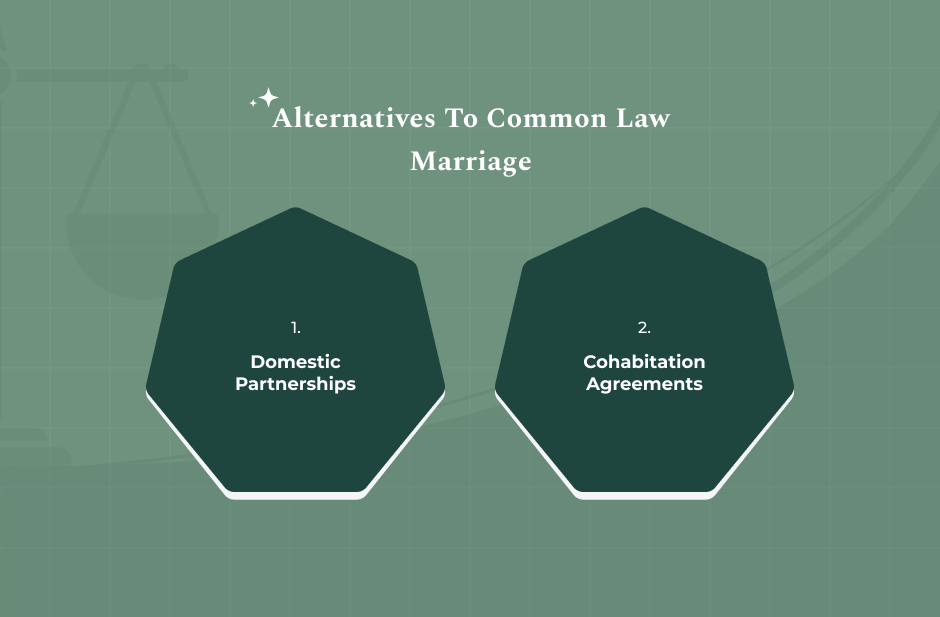A couple that merely cohabitates and a couple in common law marriage- what difference can it have? One that’s rooted in financial security and complete loss. It is one of the most widely misunderstood legal concepts in America.
Most people mistakenly believe cohabitating with someone for a few years makes a common law marriage. That is not always true.
It differs significantly from cohabitation legally. The union provides couples with the same rights as a common marriage. However, there is no marriage license or ceremony.
Therefore, it is essential to know what is common law marriage is for any individual living together with another and willing to share a future. We will examine the most critical requirements and also the precise states in which it is accepted. So, let’s begin.
Major Common Law Marriage Conditions

Common law marriage does not just happen. It requires some intention on the part of both parties. It states typically require the mutual and concurrent existence of the following four elements:
Mutual Agreement
Both parties must have an existing intent to be married. They must decide that, at this time in life, they are married, not that they will marry sometime in the future. This mutual agreement is at the heart of any common law marriage.
Living Together
The two must live together for a period. However, contrary to general folklore, there is no seven-year wonder period. Indeed, most states have no minimum time frame at all.
The cohabitation requirement simply means living together in the same way as a married couple.
Public Representation (“Holding Out”)
This is generally the most severe and most difficult part to prove. The couple must openly introduce themselves as a married couple to society. This includes introducing themselves to friends, family members, and colleagues as “my wife” or “my husband” each time.
There is no “secret” common law marriage.
Legal Capacity
Both partners should also possess the ability to contract a marriage. They should be of legal age, not related in any way that prohibits marriage, and above all, neither should already be married to another person.
If either is still legally wedded to another spouse, there is no valid common law marriage possible.
Which States Recognize Common Law Marriage?
This is a state-by-state issue. The majority of states have abolished this form of union. Nevertheless, a number of common-law marriage states offer full or limited recognition.
Full Recognition States
As of 2025, the following jurisdictions will uphold a common law marriage, provided all the specific requirements are met:
- Colorado
- District of Columbia
- Iowa
- Kansas
- Montana
- Oklahoma
[Note: Oklahoma’s legislation has been inconsistent. Experts at Sterling Lawyers advise to always consult a local attorney.]
- Rhode Island
- Texas
- Utah
Limited Or Abolished Recognition
The case is more complicated in other states. According to the National Conference of State Legislatures (NCSL), New Hampshire allows common law marriage only for limited purposes, such as probate and inheritance at the death of a spouse, and requires a three-year cohabitation period.
South Carolina still honors marriages validly entered into before July 2024, when the state Supreme Court decided to prospectively abolish this marriage.
On the other hand, states like California, Florida, and New York abolished common law marriage years ago. Irrespective of how long they live together or the name by which they call themselves, they cannot form a common-law marriage in these states.
The “Portability” Principle
A significant legal principle is involved here: if a couple enters into a legitimate common law marriage in one of those states where it is legal (like common law marriage in Texas), that marriage is legally valid if they later relocate to another state that does not recognize it (like California).
As per FindLaw, most states, even some that have prohibited the practice, enforce a common law marriage legally entered into elsewhere because of the U.S. Constitution’s Full Faith and Credit Clause.
What Are The Legal Consequences Of Common Law Marriage?
When a couple enters a valid common-law marriage, the marriage is given the same legal status as a formal wedding. This means that they acquire a full set of rights and obligations.
Rights and Obligations
Common law marriage partners are accorded the same rights in law as conventionally married couples. These include:
- Property Rights: They establish community or marital property rights, which may be a significant consideration in dividing property.
- Inheritance: A surviving spouse is entitled to inherit property from the deceased spouse to the same degree as a ceremonial spouse.
- Spousal Benefits: They are qualified for spousal Social Security benefits, pension survivorship benefits, and coverage under a partner’s health insurance plan.
- Tax Benefits: They are legally entitled and required to file joint federal and state income tax returns.
Dissolution Of A Common Law Marriage

There is no “common law divorce.” You can terminate a common law marriage after you have legally entered into one. It is the same formal legal procedure as that of ending a ceremonial marriage: divorce.
The court must legally dissolve the marriage, and all issues, such as dividing property and spousal support, must be resolved. You can’t just split up and say the common-law marriage is over.
Forming A Common Law Marriage
In the absence of a marriage license, forming a common-law marriage is usually a hard, fact-based legal battle when the union breaks down.
Evidence Required
Courts require concrete proof to determine that the three most significant factors (agreement, cohabitation, and holding out) existed simultaneously. Useful documents are:
- Joint tax returns filed under “Married – Filing Jointly.”
- Joint accounts or credit cards.
- Life insurance policies or wills that use the term “spouse” or “husband/wife” to refer to the spouse.
Testimony or affidavits from friends, family, and co-workers that the couple presented themselves and were perceived as a married couple.
Property titles or deeds that state them as “husband and wife.”
Legal Proceedings
In divorce, probate, or benefits disputes, courts will demand supporting documentation and strong testimony to definitively prove the existence of a valid common law marriage. The burden of proof is high because the state has to accept a full marital union from circumstantial evidence.
1. Common Misconceptions
It is important to know the common myths of it in order to shield yourself and your partner.
2. The Duration Myth
The belief that common law marriage becomes effective upon living together for seven years (or otherwise) is simply and downright false.
There is no waiting period in any of the states that creates a common law marriage instantly. All of the elements of law, especially the mutual understanding and public presentation, have to be there. No matter the duration, the couple lived together.
3. Automatic Status
Not every state has what states have this. Merely living in one of the states that have common law marriage does not endow you with a common law marriage. You need to be taking affirmative, public steps toward creating the intent to be married under the specific legal standards of the state.
What Are The Alternatives To Common Law Marriage?

There are alternatives to couples who wish to have some protection of their legal rights without a wedding ceremony.
1. Domestic Partnerships
Some states and cities maintain Domestic Partnership registries. This is not an extension of all marital rights but may provide some limited benefits, such as hospital visitation rights or some insurance coverage as a spouse.
2. Cohabitation Agreements
A Cohabitation Agreement is a legally binding contract between two unmarried individuals. It allows the couple to set down their rights and obligations, especially when it comes to joint property, debt, and finances.
Thus, it creates a prenuptial agreement without the wedding. It proves to be a helpful instrument in states without common law marriage.
Read Also: A Step-by-Step Guide to the Separation Agreement Template
Expert Tips And Best Practices
Partners who believe that they are or will be under a common law marriage have to take action.
1. Seek Legal Experts
Always seek the advice of lawyers to learn about your own rights and obligations, especially when you move between common law marriage states.
2. Keep Records
Keep detailed records of all joint money accounts, tax returns, and other documentation verifying the public display of your common law marriage.
3. Think About Formalizing The Union
If you have entered into a common law marriage, the simplest method to avoid further legal problems is to obtain a Declaration of Informal Marriage (offered in states like Texas).
Or, you can have a simple wedding ceremony to render the union unassailable for documentation.
Ultimately, while the option of this marriage provides legal standing for those who choose to forego the ceremony, the evidence rests solely with the couple. Disregard for the legal reality of common law marriage can have catastrophic financial consequences in the future.
Read Also: What Is BC Common Law? Know All About It!
Frequently Asked Questions (FAQs):
Understanding the nuances of common law marriage protects your future.
No. Once a valid common law marriage has been established in a jurisdiction that recognizes it, it is the equal of a ceremonial marriage in the eyes of the law.
Therefore, it requires a formal divorce decree or annulment by a court to legally dissolve the union, even if the split is very amicable.
The surviving common law spouse usually has the same rights as an intestate spouse under the law. But the surviving partner must first go before a court to prove the existence of the common law marriage. This adds significant additional time and complexity of law to the probate process.
Yes. For immigration, the United States Citizenship and Immigration Services (USCIS) will recognize a properly formed common law marriage. The couple can file an I-130 Petition for Alien Relative.
However, they will need to provide extensive documentation and proof that all the specific state requirements of it were met.

















